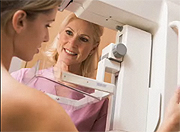
TUESDAY, Feb. 11, 2014 (HealthDay News) — The value of yearly mammograms is under fire once again, with a long-running Canadian study contending that annual screening in women aged 40 to 59 does not lower breast cancer death rates.
For 25 years, the researchers followed nearly 90,000 women who were randomly assigned either to get screening mammograms or not.
“Mammography detected many more invasive breast cancers,” said lead researcher Dr. Cornelia Baines, professor emeriti at the University of Toronto’s Dalla Lana School of Public Health. “Survival time was longer in women getting mammography.”
“[However], the number of deaths from breast cancer was the same in both groups at 25 years,” she said.
“It is increasingly being recognized that there are significant harms from screening, and that screening can do much less now than 40 years ago because of improved therapy,” Baines added. “Twenty-two percent of the mammography group with screen-detected invasive beast cancer were over-diagnosed and unnecessarily inflicted with therapy.”
Over-diagnosis is defined as the detection of harmless cancers that will not cause symptoms or problems during a patient’s lifetime.
The study, which began in 1980 in 15 screening centers in six Canadian provinces, was published Feb. 11 in the online edition of the journal BMJ.
Women in the mammography group had a total of five mammograms — one a year for five years. Those aged 40 to 49 in the mammography group and all women aged 50 to 59 in both groups also had an annual physical exam. Women aged 40 to 49 in the no-mammography group had a single physical exam followed by typical care.
During the next 25 years, 3,250 women who got screening mammographies were diagnosed with breast cancer, compared with 3,133 in the no-mammography group, according to the study. While 500 women in the mammography group died during the follow up, 505 in the no-mammography group did.
In 2009, the U.S. Preventive Services Task Force updated its recommendations on screening mammograms, suggesting them for women aged 50 to 74 every two years. Among women aged 40 to 49, the task force recommended only a discussion with a woman’s doctor on the pros and cons of screening.
But other U.S.-based organizations, including the American Cancer Society, continue to recommend annual screening mammograms for women beginning at age 40.
The American College of Radiology, which also supports annual screening mammograms for women aged 40 and older, reacted strongly to the Canadian findings. In a statement issued Feb. 11, the college called the report “an incredibly misleading analysis based on the deeply flawed and widely discredited Canadian National Breast Screening Study.”
Among those flaws, according to the college: the quality of mammograms done in the study was poor and the skills of the imaging technologists were not adequate.
The new report isn’t a surprise, said Dr. Carol Lee, chairwoman of the college’s breast imaging communications committee. “When it was first reported 20 years ago, it didn’t show a benefit,” she said.
The findings are at odds with many other reports that show a benefit for routine screening, Lee added.
“Screening mammography has been shown over and over again to decrease mortality from breast cancer,” she said.
Lee said she is “concerned [the new study] is going to discourage women from having mammograms.”
In an editorial accompanying the study, experts from the University of Oslo, the Harvard School of Public Health and other institutions agreed with the Canadian researchers that the rationale for screening needs to be reassessed by policy makers.
Baines said her research points to the value of offering screening mammograms only to those at higher risk of breast cancer.
“In time, the hope is to offer screening to a subset of the population [that has] been identified, probably by genetic markers, to be very likely to benefit from screening,” she said.
More information
To learn more about mammography, visit the American Cancer Society.
Copyright © 2025 HealthDay. All rights reserved.

